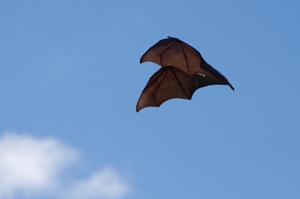Household Pests: Bats
Bats are great to have around, until they take up residence inside your home. Learn how to evict them easily, and without harming them.

Wild animals are part of what makes nature so magical, and watching them can be highly enjoyable. While it’s important to coexist with animals in relative peace, they can cause countless problems when they take up residence in our homes or gardens. In this series, our Wildlife Management Specialist, Shawn Weeks, will educate us about some common household pests, and share some strategies for keeping them under control without dangerous chemicals or poisons.
Habitat and History
Bats are warm blooded, furry mammals. They are the only mammals capable of actual flight. Bats are nocturnal animals and feed at night, most from the wing, while in air. All bats are migratory creatures, usually colonizing in caves during the cold weather months and spreading out for several hundred miles during the spring and summer. Even the most solitary species colonize together in winter.
The bones in a bat’s wings are similar to the ones found in human hands and arms. Their fingers are extended and connected by an elastic skin that grows from the side of the bat’s body. The thumbs are free from the membrane and have claws for grasping.
Bats have excellent eyesight and use actual vision for long flight. They also use echolocation for locating prey and specific locations and targets. Echolocation is basically a sonar system that allows animals to navigate by the echo from various sounds they emit. Bats give off ultra sonic sounds slowly as they forage, then quicker as they pursue and capture their prey.
There are over forty different species of bats found throughout the United States and Canada.
Diet
All common North American bats feed on insects. Different species of bats eat different insects, but as a group they are all considered beneficial because most all of the insects eaten by bats are considered nuisances. For instance, a single little brown bat can eat 1,200 mosquitoes in one hour!
Reproduction
Most species of bats give birth to a single offspring in early to late May, depending on how far north they range. The young are unable to fly until around mid July. Newborns cling to their mothers while in flight until they become too heavy and are left behind in the roost while the female feeds. Nursery colonies only contain the females and their young. Males roost in other locations during this period.
Problems, Solutions and Health Concerns
A single bat that enters a dwelling can usually be removed easily. Closing all doors to a room, and leaving a window open will generally prompt a bat to leave. You can also successfully remove a bat from a room with a large can or jar. Slowly move toward the bat, so as not to startle it, and gently put it over the bat. Slide a thick paper or piece of cardboard underneath and bring it outside to release it.
Remember to always wear leather gloves when dealing with a bat. They do have teeth, and can bite. They may be provoked to bite if they are being handled. If you are bitten while handling a bat, wash the wound with soap and water and get immediate medical treatment. Be sure to save the animal for examination. Bats are mammals, and are susceptible to rabies, as are humans, dogs, cats, etc. Fortunately, while bats are considered by many to be carriers of rabies, the actual incidence of rabies in bats is less than 1%.
If you are experiencing a large infestation of bats in your home attic or roof, there are ways of eliminating the problem without having to harm them. Note that bats do not cause structural damage, although they can leave behind guano (bat droppings), and stains on the sides of your house where they enter and exit. Depending on how large your colony is, they can also be noisy, especially when giving birth.
The best way to rid your home of bats is to seal up the structure at all points of entry. It is of the utmost importance that you do not completely seal up the bats’ entry/exit points while they are still inside your home or attic. Start out at the entry points by creating a “One Way” valve or gate. You can use a two-foot length of 4” PVC, attached by duct tape, to a soft wire mesh. Staple the mesh end to the house at the bats’ entry. This will allow the bats to exit safely, but not be able to return. The bats will not be able to grip the PVC and climb into the structure on return.
If you have a nursery colony of several mothers and pups, it is important to wait until the pups are self-sufficient, otherwise their mothers will not be able to feed them, and you will have several dead bat pups rotting inside your home. You definitely do not want that! Most bats can live on their own by the age of six weeks, so late August or early September is the best time for exclusion.
After installing the one-way valves, you can proceed to apply a sealant to all of the facial boards where they meet the siding, openings in the soffits, louvers and any other openings. You can use caulking, expansion foam, petroleum soaked rope, or fine mesh screening. Keep the one-way valves on for at least four nights, allowing the bats to leave safely, on their own. Then remove the valves and apply your sealant to those areas.
If you want to continue to welcome bats onto your property — just not inside your home — you can build or buy one or more bat houses as an alternative. Bat boxes can be secured right to the side of your home, or to trees or posts, and a small box can accommodate dozens of bats. Remember, the definition of “pest” is in the eye of the beholder. An animal that you don’t want in your home can be desirable outside of it. Bats, with their mosquito munching tendencies, are the perfect example. And bat guano is great for your garden and lawn!
There are many techniques and materials that can be used to rid your house of bats. Shawn has been performing bat exclusion work for over twenty years. If you have further technical questions, he can be contacted at [email protected]

Shawn Weeks
Shawn is a lifelong New Englander. He lives in Canton, Conn., with his wife Tami, mother, sister, and her three children. He and his wife have two grown children and two grandchildren. Shawn is an avid hunter, fisherman, and gardener. He is also a writer, a nuisance wildlife professional, small scale farmer, and scout leader. You can email him at [email protected].





